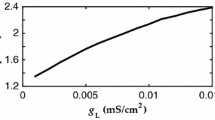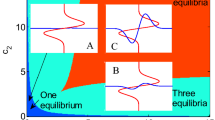Abstract
Central pattern generators (CPGs) consisting of interacting groups of neurons drive a variety of repetitive, rhythmic behaviors in invertebrates and vertebrates, such as arise in locomotion, respiration, mastication, scratching, and so on. These CPGs are able to generate rhythmic activity in the absence of afferent feedback or rhythmic inputs. However, functionally relevant CPGs must adaptively respond to changing demands, manifested as changes in oscillation period or in relative phase durations in response to variations in non-patterned inputs or drives. Although many half-center CPG models, composed of symmetric units linked by reciprocal inhibition yet varying in their intrinsic cellular properties, have been proposed, the precise oscillatory mechanisms operating in most biological CPGs remain unknown. Using numerical simulations and phase-plane analysis, we comparatively investigated how the intrinsic cellular features incorporated in different CPG models, such as subthreshold activation based on a slowly inactivating persistent sodium current, adaptation based on slowly activating calcium-dependent potassium current, or post-inhibitory rebound excitation, can contribute to the control of oscillation period and phase durations in response to changes in excitatory external drive to one or both half-centers. Our analysis shows that both the sensitivity of oscillation period to alterations of excitatory drive and the degree to which the duration of each phase can be separately controlled depend strongly on the intrinsic cellular mechanisms involved in rhythm generation and phase transitions. In particular, the CPG formed from units incorporating a slowly inactivating persistent sodium current shows the greatest range of oscillation periods and the greatest degree of independence in phase duration control by asymmetric inputs. These results are explained based on geometric analysis of the phase plane structures corresponding to the dynamics for each CPG type, which in particular helps pinpoint the roles of escape and release from synaptic inhibition in the effects we find.



















Similar content being viewed by others
References
Brown, T. (1911). The intrinsic factors in the act of progression in the mammal. Proceedings of the Royal Society of London Series B, 84, 308–319.
Brown, T. (1914). On the nature of the fundamental activity of the nervous centres; together with an analysis of the conditioning of rhythmic activity in progression, and a theory of the evolution of function in the nervous system. Journal of Physiology, 48, 18.
Butera, R., Rinzel, J., & Smith, J. (1999). Models of respiratory rhythm generation in the pre-Bötzinger complex. I. Bursting pacemaker neurons. Journal of Neurophysiology, 81, 382–397.
Calabrese, R. (1995). Half-center oscillators underlying rhythmic movements. In M. Arbib (Ed.), The handbook of brain theory and neural networks (pp. 444–447). Cambridge: MIT.
Curtu, R., Shpiro, A., Rubin, N., & Rinzel, J. (2008). Mechanisms for frequency control in neuronal competition models. SIAM Journal on Applied Dynamical Systems, 7, 609–649.
Grillner, S. (1985). Neurobiological bases of rhythmic motor acts in vertebrates. Science, 228, 143–149.
Grillner, S. (2006). Biological pattern generation: The cellular and computational logic of networks in motion. Neuron, 52, 751–766.
Halbertsma, J. (1983). The stride cycle of the cat: The modelling of locomotion by computerized analysis of automatic recordings. Acta Physiologica Scandinavica Supplementum, 521, 1–75.
Harris-Warrick, R. (1993). Pattern generation. Current Opinion in Neurobiology, 3, 982–988.
Izhikevich, E. (2006). Dynamical systems in neuroscience: The geometry of excitability and bursting. Cambridge: MIT.
Lafreniere-Roula, M., & McCrea, D. (2005). Deletions of rhythmic motoneuron activity during fictive locomotion and scratch provide clues to the organization of the mammalian central pattern generator. Journal of Neurophysiology, 94, 1120–1132.
Lundberg, A. (1981). Half-centres revisited. In J. Szentagothai, M. Palkovits, & J. Hamori (Eds.), Regulatory functions of the CNS. Motion and organization principles (pp. 155–167). Budapest: Pergamon Akadem Kiado.
Marder, E. (2000). Motor pattern generation. Current Opinion in Neurobiology, 10, 691–698.
Marder, E., & Bucher, D. (2001). Central pattern generators and the control of rhythmic movements. Current Biology, 11, 986–996.
Marder, E., Bucher, D., Schulz, D., & Taylor, A. (2005). Invertebrate central pattern generation moves along. Current Biology, 15, 685–699.
Marder, E., & Calabrese, R. (1996). Principles of rhythmic motor pattern generation. Physiological Reviews, 76, 687–717.
Matsuoka, K. (1987). Mechanisms of frequency and pattern control in the neural rhythm generators. Biological Cybernetics, 56, 345–353.
McCrea, D., & Rybak, I. (2007). Modeling the mammalian locomotor CPG: Insights from mistakes and perturbations. Progress in Brain Research, 165, 235–253.
Mischenko, E., Kolesov, Y., Kolesov, A., & Rozov, N. (1994). Asymptotic methods in singularly perturbed systems. New York: Plenum.
Olypher, A., Cymbalyuk, G., & Calabrese, R. (2006). Hybrid systems analysis of the control of burst duration by ed calcium current in leech heart interneurons. Journal of Neurophysiology, 96, 2857–2867.
Orlovskiĭ, G., Deliagina, T., & Grillner, S. (1999). Neuronal control of locomotion: From mollusc to man. Oxford: Oxford University Press.
Rowat, P., & Selverston, A. (1993). Modeling the gastric mill central pattern generator of the lobster with a relaxation-oscillator network. Journal of Neurophysiology, 70, 1030–1053.
Rubin, J. (2006). Bursting induced by excitatory synaptic coupling in non-identical conditional relaxation oscillators or square-wave bursters. Physical Review E, 74, 021917.
Rubin, J., & Terman, D. (2000). Analysis of clustered firing patterns in synaptically coupled networks of oscillators. Journal of Mathematical Biology, 41, 513–545.
Rubin, J., & Terman, D. (2002). Geometric singular perturbation analysis of neuronal dynamics. In B. Fiedler (Ed.), Handbook of dynamical systems. Towards applications (vol. 2). Amsterdam: Elsevier.
Rubin, J., & Terman, D. (2004). High frequency stimulation of the subthalamic nucleus eliminates pathological thalamic rhythmicity in a computational model. Journal of Computational Neuroscience, 16, 211–235.
Rybak, I., Shevtsova, N., Lafreniere-Roula, M., & McCrea, D. (2006). Modelling spinal circuitry involved in locomotor pattern generation: Insights from deletions during fictive locomotion. Journal of Physiology, 577, 617–639.
Selverston, A., & Moulins, M. (1985). Oscillatory neural networks. Annual Review of Physiology 47, 29–48.
Shpiro, A., Curtu, R., Rinzel, J., & Rubin, N. (2007). Dynamical characteristics common to neuronal competition models. Journal of Neurophysiology, 97, 462–473.
Sirota, M., & Shik, M. (1973). The cat locomotion elicited through the electrode implanted in the mid-brain. Sechenov Physiological Journal of the USSR, 59, 1314–1321.
Skinner, F., Kopell, N., & Marder, E. (1994). Mechanisms for oscillation and frequency control in reciprocally inhibitory model neural networks. Journal of Computational Neuroscience, 1, 69–87.
Skinner, F., Turrigiano, G., & Marder, E. (1993). Frequency and burst duration in oscillating neurons and two-cell networks. Biological Cybernetics, 69, 375–383.
Sohal, V., & Huguenard, J. (2002). Reciprocal inhibition controls the oscillatory state in thalamic networks. Neurocomputers, 4, 653–659.
Somers, D., & Kopell, N. (1993). Rapid synchronization through fast threshold modulation. Biological Cybernetics, 68, 393–407.
Sorensen, M., DeWeerth, S., Cymbalyuk, G., & Calabrese, R. (2004). Using a hybrid neural system to reveal regulation of neuronal network activity by an intrinsic current. Journal of Neuroscience, 24, 5427–5438.
Tabak, J., O’Donovan, M., & Rinzel, J. (2006). Differential control of active and silent phases in relaxation models of neuronal rhythms. Journal of Computational Neuroscience, 21, 307–328.
Taylor, A., Cottrell, G., & Kristan, Jr., W. (2002). Analysis of oscillations in a reciprocally inhibitory network with synaptic depression. Neural Computation, 14, 561–581.
Tazerart, S., Viemari, J., Darbon, P., Vinay, L., & Brocard, F. (2007). Contribution of persistent sodium current to locomotor pattern generation in neonatal rats. Journal of Neurophysiology, 98, 613.
Wang, X., & Rinzel, J. (1992). Alternating and synchronous rhythms in reciprocally inhibitory model neurons. Neural Computation, 4, 84–97.
Yakovenko, S., McCrea, D., Stecina, K., & Prochazka, A. (2005). Control of locomotor cycle durations. Journal of Neuroscience, 94, 1057–1065.
Zhong, G., Masino, M., & Harris-Warrick, R. (2007) Persistent sodium currents participate in fictive locomotion generation in neonatal mouse spinal cord. Journal of Neuroscience, 27, 4507.
Acknowledgements
S. Daun received support from NIH grant R01 HL76137. J.E. Rubin received support from NSF award DMS 0716936. I.A. Rybak was supported by NIH grants RO1 NS048844 and RO1 NS057815.
Author information
Authors and Affiliations
Corresponding author
Additional information
Action Editor: Frances K. Skinner
Appendix
Appendix
We summarize some central notation used in this paper in Table 4. In the following subsections, we list the auxiliary functions and parameter values used in the three example systems that we consider, as introduced in Section 2.2. The XPPAUT code for these systems is available at www.math.pitt.edu/~rubin/pub/CPGFILES/.
1.1 A.1 Model featuring the persistent sodium current (Butera et al. 1999)
The ordinary differential equations for the model featuring the persistent sodium current are
with associated functions
where C m = 0.21, g nap = 10, g l = 2.8, e na = 50, e l = − 65, e syn = − 80, θ m = − 37, σ m = − 6, θ h = − 30, σ h = 6, ε = 0.01, θ syn = − 43, σ syn = − 0.1, g syn = 1, g app = 0.19, α = 1, and β = 1 (fast decay) or β = 0.08 (slow decay).
1.2 A.2 Model featuring postinhibitory rebound (Rubin and Terman 2004; Sohal and Huguenard 2002)
For the model featuring postinhibitory rebound, the relevant differential equations are
with associated functions
where g T = 4, v ca = 90, θ m = − 40, σ m = 7.4, θ h = − 70, σ h = − 4, θ ht = − 50, σ ht = − 3, g l = 0.4, v l = − 70, t 0 = 30, t 1 = 200, g syn = 1.4, v syn = − 85, θ syn = − 35, σ syn = − 0.1, g app = 0.01, α = 1, and β = 1 (fast decay) or β = 0.05 (slow decay).
1.3 A.3 Model featuring adaptation (modified from Izhikevich 2006)
The model featuring adaptation is given by the differential equations
with associated functions
In case 1, C m = 21, g syn = 2, g app = 0.7, e l = − 55, θ m = − 34, σ m = − 5, e k = − 85, g l = 1, e syn = − 70, k = 1, τ s = 1 (fast decay) or τ s = 400 (slow decay), σ syn = − 5, θ syn = − 20, θ ca = − 34, σ ca = − 8.0, k ca = 22.5, ε = 5e − 05, k ahp = 0.7, v ca = 140, g ahp = 7, g ca = 0.05, g ca1 = 1, and ca base = 0.08. In case 2, the same parameters are used except g syn = 6 (fast decay) or g syn = 4 (slow decay), e syn = 50, k = 0.02 (fast decay) or k = 0.002 (slow decay), σ syn = − 4, and θ syn = 20.
Rights and permissions
About this article
Cite this article
Daun, S., Rubin, J.E. & Rybak, I.A. Control of oscillation periods and phase durations in half-center central pattern generators: a comparative mechanistic analysis. J Comput Neurosci 27, 3–36 (2009). https://doi.org/10.1007/s10827-008-0124-4
Received:
Revised:
Accepted:
Published:
Issue Date:
DOI: https://doi.org/10.1007/s10827-008-0124-4




